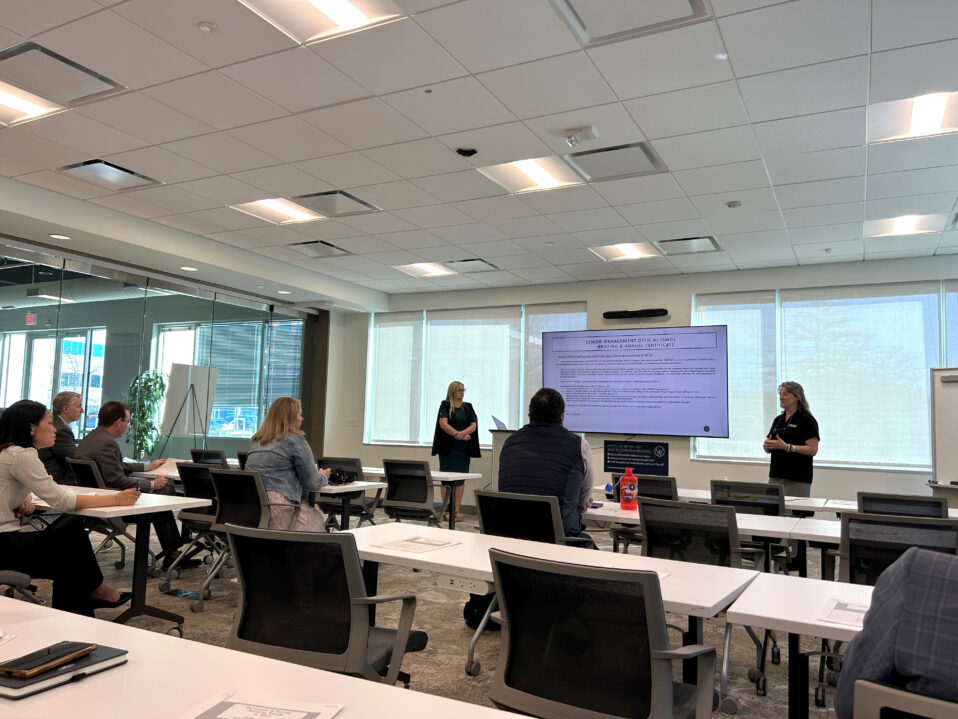 After tense months of waiting, Synergy ECP finally got the news this spring that it had been hoping and preparing for. The Service-Disabled Veteran-Owned Small Business had landed two large prime contracts to serve Fort Meade clients.
After tense months of waiting, Synergy ECP finally got the news this spring that it had been hoping and preparing for. The Service-Disabled Veteran-Owned Small Business had landed two large prime contracts to serve Fort Meade clients.
For Synergy ECP, the contract announcements constituted a major step forward into roles where it would prime work on one team of 56 companies and another 26-company team where members ranged from “small firms with just a few employees to CACI, a multi-billion dollar, publicly traded company,” said Bruce Howard, CEO. But the process to reach that milestone was not easy, quick or risk-free.
Contracting opportunities for small businesses — including some very large opportunities — are plentiful at Fort Meade. However, conditions over the past two years – pandemic-induced contracting delays, loss of contracting staff, changes in contract vehicles, mergers and acquisitions of companies, the arrival of startup firms, and heightened competition from the commercial sector – have produced considerable changes in the business environment.
Contractors need to understand those changes and their implications in order for companies to succeed in their business plans and Fort Meade agencies to succeed in their missions.
Two conditions, in particular, present large and shifting challenges to contractors.
The Contracting Process
Competing for federal contracts was always a complicated process, then the pandemic added new layers of complexity. Decisions to extend contracts early in the pandemic diminished new opportunities for small companies, said Angie Lienert, President and CEO of IntelliGenesis LLC. New contract competitions have since increased dramatically but a shortage of federal contracting staff has slowed the process, she added.
“Small businesses submit contract proposals and it literally can be two years later before you hear a decision,” Lienert said. “Locking in key people for that long is challenging and it’s difficult for small businesses to make a big investment in doing a contract proposal and not seeing any return on that investment for years.”
The current contracting environment also makes it more complicated to determine which opportunities to pursue. Quarterly forecasts project upcoming contracting activity, “but the forecasts slip. You may plan to go after two or three opportunities. But if the schedule slips and those opportunities all end up happening at the same time, you may have to scale back your plan and only go after one,” she said.
The realities of contracting mean that many small companies need to diversify, but carefully.
In the past year, IntelliGensis opened its IG Labs – an 8,000-square-foot facility focused on artificial intelligence, machine learning, data science and artificial reality/virtual reality – and began to pursue more work with commercial clients. Lienert, however, cautions that small companies need to avoid pursuing numerous, disparate opportunities.
“Focus on areas where you have expertise, a recruiting arm and a pipeline,” she said. “That is going to give you the biggest bang for your buck and allow you to negotiate better rates. If you can’t get good rates, you aren’t going to be able to get staff.”
Small companies also need to fully explore the range of contracting opportunities they could have within a single government client, said Chad Michael, President of Synergy ECP.
“One thing that I think a lot of small businesses do – and I think they do it too early – is instead of focusing on one agency, they spread themselves too thin and cast too wide of a net,” Michael said.
Although Synergy has done select business with other clients, “I have been at NSA for 31 years now. I have concentrated on my one primary customer, gotten to know that customer very well and worked to make Synergy the best contractor to that customer,” he said.
Competition for Talent
“The biggest challenge for every company doing business at Fort Meade is staffing,” said Bill Dunahoo, Principal and Co-founder of Nexxis Solutions.
The Fort Meade Region has long wrestled with talent shortages and challenges in acquiring security clearances for contract workers. Following a year of research, the FMA Education and Workforce Steering Committee released a white paper outlining the top challenges to acquiring cyber security and Information Technology talent and proposing initiatives to ease them.
Those longstanding challenges, however, have been compounded by other circumstances recently – specifically, the inability of some Fort Meade work to support remote or hybrid work, and growing competition for talent from Amazon, Google and other major commercial employers.
Companies have adopted different approaches to bolster their talent recruitment and retention.
For years, Synergy ECP has pursued a strategy of landing contracts for varied levels of work, Howard said. Its awards have ranged from contracts that provide entry-level IT services, including access control and help desk support, to contracts for high-end network engineering services.
“We have worked to create a pipeline so people can progress in their careers without having to leave the company,” he said. “It allows us to create opportunities for, say, a person who has been working at a mid-level position on one contract for a few years, to move into a senior position on a new contract. I think that’s a big advantage for us.”
IntelliGenesis has boosted its recruitment efforts through internship programs. The company provides small cohorts of college students and transitioning military personnel with carefully planned opportunities to work on leading technology, participate in project work and receive mentorship, Lienert said.
Assorted small companies leverage their size to provide more attractive employment packages and corporate culture, said Paul Gentile, Owner of Panther LLC.
“One of the advantages that small businesses have is the ability to potentially provide more robust benefits,” said Paul Gentile, Owner of Panther LLC.
Because small firms typically have low overhead and administrative costs, they can sometimes offer benefits – including, completely free medical coverage, enhanced training and perks, such as free membership to big box stores or streaming services – and still keep their rates competitive on government contract proposals, Gentile said.
Leaders of small, young companies also have the opportunity to establish modern, attractive workspaces and spend more time connecting with individual employees.



